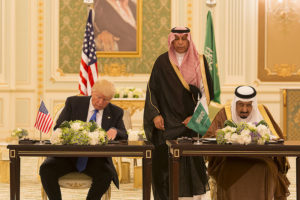
President Donald Trump and King Salman bin Abdulaziz Al Saud of Saudi Arabia sign a Joint Strategic Vision Statement for the United States and the Kingdom of Saudi Arabia, during ceremonies, Saturday, May 20, 2017, at the Royal Court Palace in Riyadh, Saudi Arabia. (Official White House Photo Shealah Craighead)
At The National Interest,Payam Mohseni and Ammar Nakhjavani warn American politicians about taking sides in the Shia-Sunni conflict currently boiling in the Middle East. The writers suggest that getting to close to the leaders of the Sunni movement, Saudi Arabia and other Gulf states, could drive away moderate Shia and even moderate Sunni countries and groups in the region. They write (abridged):
If the United States wishes to cooperate with leading political parties and states of Iraq and Lebanon, it must consider mainstream Shia concerns and undertake a balanced approach with regional powers. Otherwise, America will seem biased towards Wahhabi or Salafi currents which are tied to the Persian Gulf monarchies that have been at the forefront of lauding the administration’s policies towards Iran.
This will disadvantage potential cooperation with moderate Shia forces such as al-Sistani. Furthermore, American bias in favor of Sunnis will increase tensions with regional powers such as Turkey and Qatar which have recently gravitated closer to Iran in an effort balance against Saudi Arabia. Another example includes Kuwait and Oman also striking a balanced tone for similar reasons. The United States would do well to observe and emulate this delicate balancing act.
Read more here.
If you’re willing to fight for Main Street America, click here to sign up for my free weekly email.




